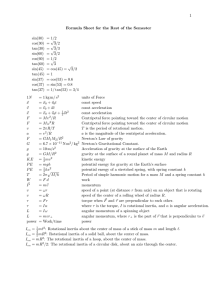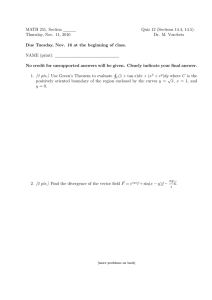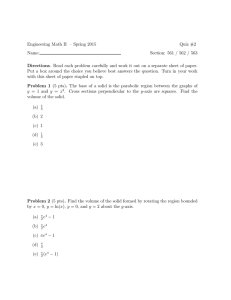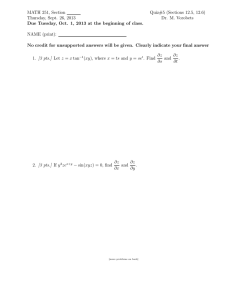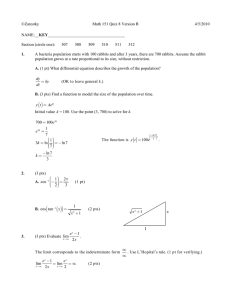1
advertisement
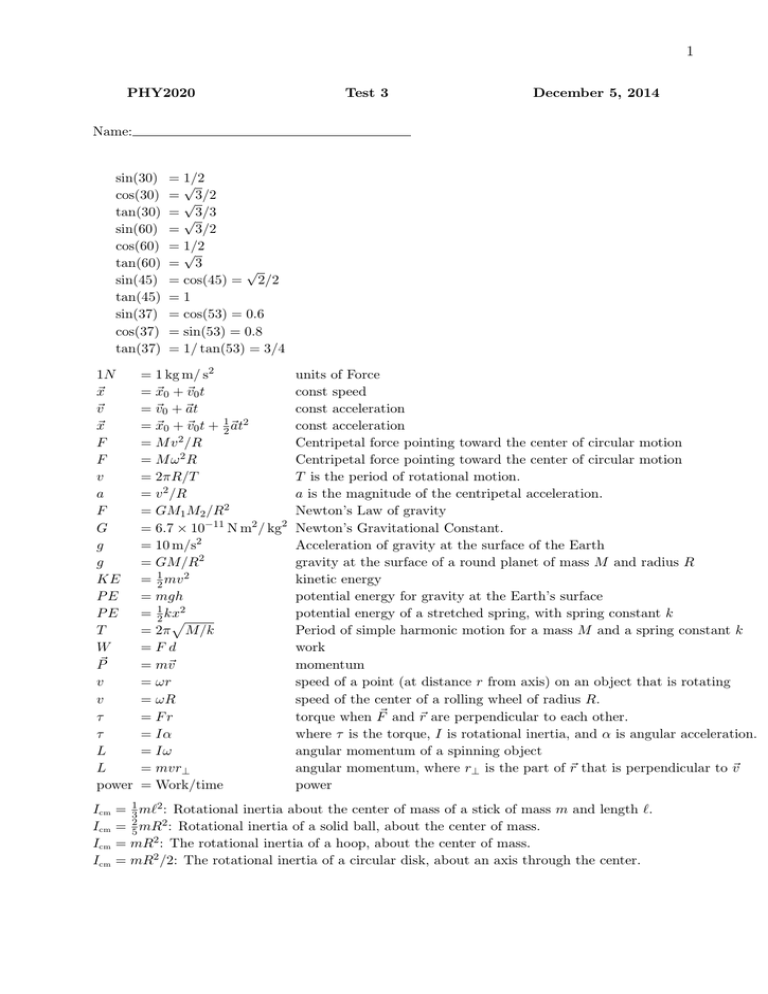
1 PHY2020 Test 3 December 5, 2014 Name: sin(30) cos(30) tan(30) sin(60) cos(60) tan(60) sin(45) tan(45) sin(37) cos(37) tan(37) = 1/2 √ = √3/2 = √3/3 = 3/2 = 1/2 √ = 3 √ = cos(45) = 2/2 =1 = cos(53) = 0.6 = sin(53) = 0.8 = 1/ tan(53) = 3/4 = 1 kg m/ s2 = ~x0 + ~v0 t = ~v0 + ~at = ~x0 + ~v0 t + 12 ~at2 = M v 2 /R = M ω2R = 2πR/T = v 2 /R = GM1 M2 /R2 = 6.7 × 10−11 N m2 / kg2 = 10 m/s2 = GM/R2 = 21 mv 2 = mgh 2 = 12 kx p = 2π M/k =Fd = m~v v = ωr v = ωR τ = Fr τ = Iα L = Iω L = mvr⊥ power = Work/time 1N ~x ~v ~x F F v a F G g g KE PE PE T W P~ Icm Icm Icm Icm units of Force const speed const acceleration const acceleration Centripetal force pointing toward the center of circular motion Centripetal force pointing toward the center of circular motion T is the period of rotational motion. a is the magnitude of the centripetal acceleration. Newton’s Law of gravity Newton’s Gravitational Constant. Acceleration of gravity at the surface of the Earth gravity at the surface of a round planet of mass M and radius R kinetic energy potential energy for gravity at the Earth’s surface potential energy of a stretched spring, with spring constant k Period of simple harmonic motion for a mass M and a spring constant k work momentum speed of a point (at distance r from axis) on an object that is rotating speed of the center of a rolling wheel of radius R. torque when F~ and ~r are perpendicular to each other. where τ is the torque, I is rotational inertia, and α is angular acceleration. angular momentum of a spinning object angular momentum, where r⊥ is the part of ~r that is perpendicular to ~v power = 31 m`2 : Rotational inertia about the center of mass of a stick of mass m and length `. = 25 mR2 : Rotational inertia of a solid ball, about the center of mass. = mR2 : The rotational inertia of a hoop, about the center of mass. = mR2 /2: The rotational inertia of a circular disk, about an axis through the center. 2 The mass of an electron is 9 × 10−31 kg. Unit of a magnetic field is 1 Tesla = 1 N/(1Coulomb × 1 m/s) = 1 kg/(1C· s) 1C −1C 1e− V P F k F F F = 6 × 1018 protons = 6 × 1018 electrons = −1.6 × 10−19 C = IR Ohm’s law = IV Power loss 2 = kq1 q2 /r Coulomb’s law 9 2 = 9 × 10 N m / C2 = qE, Force on a charge in an electric field. ~ : for a charge moving in a circle in a magnetic field, the force points inward. = qvB when ~v ⊥B ~ : for a charge moving in a magnetic field. = 0 when ~v k B vs = 340 m/s speed of sound in air λf = vsound , λ = wavelength, f = frequency in Hz, ω = 2πf angular frequency in radians/s femitted Doppler effect for an airplane approaching fheard = vvsound sound −vplane fheard = vsound femitted vsound +vplane Doppler effect for an airplane moving away For an organ pipe of length L and with one end open: λn = 4L/(1 + 2n), where n is an integer. The “fundamental” mode has n = 0. Simple Harmonic Motion: (also known as a mass on a spring, or a simple pendulum) F T T x(t) = −kx, p = 2π pm/k = 2π `/g = A cos(2πf t), where k = spring constant = period = period, where ` is the length of a pendulum where A = Amplitude, 1/T = f = frequency in Hz, t = time, x(t) = displacement as a function of t 3 1. (6 pts) A spring is hanging vertically. You attach a 1 kg mass to the bottom of the spring and it stretches down by a distance of 20 cm. (a) What is the spring constant of the spring? (b) With the 1 kg mass still on the end of the spring, you pull down on the mass stretching the spring by an additional distance of 10 cm. While you hold the mass in place, what is the magnitude of the force that you are exerting on the mass? (c) When you release the mass what is the period of its subsequent oscillations? 2. (2 pts) A small bee-bee (a little copper ball) has a mass of 1 gram= 1 × 10−3 kg. It is moving with a velocity of 1 m/s perpendicular to a uniform magnetic field whose field strength is 2 Tesla. And the path of the bee-bee is a circle of radius R = 0.1 m. What is the electric charge on the bee-bee. Assume that the charge is positive. 4 3. (4 pts) An electrical circuit is sketched below. A 30 Volt battery is connected to three resistors, with resistances R5 = 5 Ohm, and R3 = 3 Ohm and R? is unknown. But the current through the circuit is a steady 3 Amps. (a) What is the resistance of R? ? (b) What is the rate of power lost in the resistors? 4. (6 pts) Two small copper balls, one of mass 1 kg the other of mass 2 kg, each have an electric charge of +1 C and +2 C, respectively, as shown in the diagram. The balls are held together by a strong, insulating thread that is 1 m long. (a) What is the tension in the thread? (b) What is the magnitude of the electric force exerted on the 1 kg ball? (c) What is the magnitude of the electric force exerted on the 2 kg ball? (d) The thread is then cut. What is the initial acceleration of the 1 kg ball just as the thread is cut? (e) What is the initial acceleration of the 2 kg ball just as the thread is cut? 5 5. (4 pts) 1 C of positive electric charge is located at x = 0 and 2 C of positive charge are located at x = 4 m. Where would a third charge Q = 1 C be located on the x-axis (between the other two charges) such that the electric force on the third charge would be zero? 6. (4 pts) A particular automobile has the frequency of its horn carefully tuned to be 99 Hz = 99 cycles when it is not moving. sec (a) What is the frequency of the sound that you actually hear when the car is moving directly toward you at a speed of 34 m/s, which is 1/10 of vsound ? You may recall that the speed of sound is 340 m/s.(Hint: Use the Doppler shift formula.) (b) What is the frequency of the sound that you actually hear when the car is moving directly away from you at a speed of 34 m/s? 6 7. (2 pts) In class recently, I had a glass tube on the desktop, and you could see the light coming from a current of electrons running along its length. When I brought one end of a bar magnet (held horizontally and perpendicular to the tube) up to the tube, in which direction was the current of electrons deflected? Circle one of these choices: (A) Either to the front or the back of the tube (depending upon which pole of the magnet was approaching) (B) Either to the top or the bottom of the tube (depending upon which pole of the magnet was approaching) (C) The magnet had no effect on the path of electrons. 8. (4 pts) In class recently, I had a radio-wave transmitter on the desktop with the antenna being horizontal. I also had a receiving antenna that I held in my hand. (a) When I held the receiving antenna perpendicular to the transmitting antenna, which of the following happened next? (A) We heard static noise. (B) We heard a humming noise. (C) We saw a little light bulb light up. (D) Nothing happened. (b) When I held the receiving antenna parallel to the transmitting antenna, which of the following happened next? (A) We heard static noise. (B) We heard a humming noise. (C) We saw a little light bulb light up. (D) Nothing happened.
